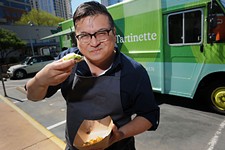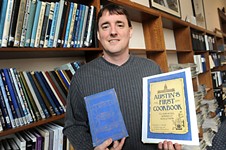Not Just Plain Vanilla
The Many Flavors of Austin's Adams Extract Company
By MM Pack, Fri., Nov. 2, 2001

"Home of Adams' Extract." You may have noticed the neon deco sign on the roof of the distinctively low-slung Moderne building, set back from I-35 just south of Slaughter Lane and rather dramatically surrounded by prairie grassland. And if you thought about it, you might have made the connection to those unassuming little brown bottles of Adams Best vanilla that have graced countless kitchen cabinets in countless Texas households since the turn of the century.
What you might not know is that, unlike Betty Crocker, there really is a Mr. Adams, and he still makes the extracts from top-secret family formulas. The relentlessly busy octogenarian John G. Adams Sr., company president, works seven days a week and is a hard man to catch up with, but recently he slowed down long enough to tell me about his family's venerable Austin condiments business.
The company roots were planted when his grandfather, John A. Adams, a Michigan pharmacist who moved his family to Beeville in 1905, developed the vanilla extract formula because his wife wasn't happy with existing products. When she professed delight with the taste and performance of his flavoring, he responded with "Well, that's old man Adams' best."
Demonstrating classic frontier spirit, John A.'s sons, Fred and Don, helped their father bottle and label the product at night, and they sold it door-to-door during the day, with a money-back guarantee. By 1917, Fred Adams had received UT's first BA in business administration, and had bought the company from his father. Convinced that Austin offered more potential than Beeville, he built a two-story brick building at the corner of San Gabriel and 22nd Street, and he moved the company there in 1922. Fred's son, John G. (the current president), grew up in the family home just around the corner on 23rd Street.
With a grin as wide as the prairie outside, he told me, "I started working in the business when I was 5 years old. My father said, 'If you're old enough to go to school, you're old enough to work.' For a nickel an hour, my job was to fill one-gallon jugs of alcohol from 55-gallon drums. By the time I was in junior high, I was making all the extracts. The summer I was 15, my father took the rest of the family on a vacation. I stayed here and was in charge for three months while he was away. I wrote him everyday and he wrote back, advising me about running the business."
During World War II, John G. was an Army Air Force pilot and squadron leader, and he told me that he liked flying so much that he might have stayed on after the war, except that he felt he should come home and continue with the family business. He returned to UT and received a BA in chemistry; he was responsible for developing many of the new flavorings in the company's growing product line. In 1947, he designed and built the production line for the new food colorings. (Today, those little boxes of four primary food colors still look the same as they did when, as children, my sisters and I used them to make pastel cake frostings. And once, as an April Fool's joke on my mother, I used the Adams blue and red colors to dye the celery stalks in the refrigerator.)
Currently, there are 40 extracts and food colorings listed on the company Web site (www.adamsextract.com). When I asked Adams exactly what an extract was, he defined it as a flavor that is extracted from a botanical and suspended in alcohol. "You know, like when you twist a lemon peel, that little spray of oil that comes out contains lemon flavor. The trick is to capture that flavor, and the process depends on which botanical you're working with." However, he explained that for some flavors, like strawberry, banana, and pineapple, it just hasn't been practical to extract natural flavor essences. For those, they've created artificial flavors. Adams certainly knows his chemistry of flavors; he was the first Texan admitted to the Society of Flavor Chemists and is the only Texan to have served as president and board member of the Flavor and Extract Manufacturers of the United States.
Regarding the company's move to its current location near Manchaca, Adams remembered, "In 1950, we were still doing all our production by hand, filling the little bottles with a siphon. For the overflow storage, we were renting 13 garages from our neighbors around San Gabriel. Then we got an order for 150,000 bottles of Adams Best for a cake mix promotion. I knew we'd better institute some mechanized processes, and we just didn't have the space.
"My Dad and I had different ideas about what we needed for the new location, so I bought 128 acres on I-35 and proposed to him that I build the new plant there and lease it to the company. And that's what we did. At the time, I-35 was just a two-lane road, but I knew it would eventually become a major highway, and it made sense to be out there for more efficient shipping. The Austin architectural firm Lundgren and Maurer designed this building; we built it in 1955 and we've been here ever since. UT architecture students come out here to look at it all the time."
As the company expanded its physical plant, they also multiplied their product lines. Although the original Adams Best vanilla extract still remains the No. 1 seller (the food colorings are No. 2), the line of spices they instituted in 1959 now constitutes 70% of the business. The biggest sellers are the basic items -- black pepper, garlic powder, chili powder, cumin, cayenne -- but over the years, they've created a wide variety of highly specialized spice blends, such as brisket rub, menudo spice, Cajun bean seasoning, and pizza pepper.
Within the last year, Adams has acquired three Louisiana flavoring businesses -- Rex Pure Foods in New Orleans ("The Commander's Palace uses Rex products; we're real proud of that"), Louisiana Gourmet in Natchitoches, and Arisé in Thibodeaux. These remain in Louisiana, but are now divisions of the Adams Company. In addition, Adams is in partnership with Texas Traditions, a company that makes boutique jellies, seasonings, and mustards; the company also manufactures some private-label products, such as Aaron Neville's New Orleans Seasoning Blend. Adams says modestly, "We're still growing a little bit."
The largest flavoring business in the state, the company now works out of four locations around Austin. They usually employ around 130 people, but there are temporary increases every autumn, which is the busy season in the world of condiments. Gloria Bryant, a vice-president who started her career at Adams 21 years ago, told me that 40% of the business occurs in October, November, and December. "Think about it. People start baking again after the summer heat is over. They also start preparing for their holiday meals and baking. Some folks throw out all their old spices and start fresh each year." Although a vice-president, Bryant had spent all day in the spice manufacturing plant, helping fill orders. "That's just the kind of company we are," she said. "Lots of times, we close the corporate offices at 5, and everyone goes to the factory to help get the orders out. If things get busy enough, Mr. Adams will be out on the floor with everyone else."
The next order of business on the Adams agenda is a major building program to consolidate all the Austin facilities into one location. For the planned new plant, they purchased 91 acres in Hays County, east of Buda. They'll still be on I-35, just down the road from the current corporate site. Once some city and county jurisdictional issues are finally resolved, construction is projected to commence soon.
An unusual aspect of the project's planning phase was that Adams went to the UT School of Architecture for some fresh views about gracefully and usefully integrating the new facility into the surrounding community. He told me, "What I wanted was ideas from the students that I might not come up with myself. They're young and they think differently." For the spring 2000 semester, assistant professor Steven Moore used the company's proposed expansion as the subject for third-year students' study of design, building construction, and environmental control systems. Adams provided a stipend for the students to prepare the results into professional portfolios, which were presented to company representatives and to the project architect, Tim Aynesworth.
Not surprisingly, the Adams Company continues to be a family affair. John G. Adams Jr. started working when he was about 10 years old; currently, he is vice-president and manages the spice division. Daughter Linda Adams is a company director. There are four children in the fifth generation, and Adams Sr. says he won't be surprised if at least some of them want to join the business. "I think one of my granddaughters wants to be a lawyer. That's great; we could use a lawyer in the family."
When I inquired if Adams were looking forward to retirement, he replied with alacrity, his blue eyes snapping. "No way. This business is my life. And I've got to get a few things done while I'm still young." ![]()








